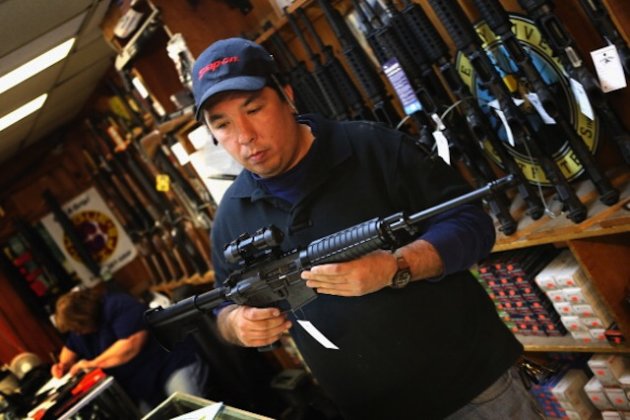 Jason Zielinski shows a customer an AR-15 style rifle at Freddie Bear Sports sporting goods store. (Scott Olson/Getty??
Jason Zielinski shows a customer an AR-15 style rifle at Freddie Bear Sports sporting goods store. (Scott Olson/Getty??
Vice President Joe Biden announced Thursday that he will recommend new gun control measures to President Barack Obama, which include more comprehensive background checks on gun buyers and limits on the sizes of ammunition magazines. The proposal could lead to the most significant move on guns in 20 years, but one regulation highly coveted by gun control advocates is notably missing: a ban on assault weapons.
In 1994, President Bill Clinton managed to push through a sweeping ban on certain kinds of semi-automatic weapons, dealing a crushing blow to the National Rifle Association and other gun lobbyists and sparking a political backlash that helped Republicans reclaim the House and Senate for the first time in 50 years.
That ban, which expired 10 years later in 2004, is still seen as the gold standard by many gun control advocates, who have been fighting in vain to get it reinstated?with some modifications?for years. Since the horrific Dec. 14 school shooting in Newtown, Conn., that left 20 first graders dead and sparked a national conversation about the nation's gun violence problem, many advocates think they see their chance.
"It is time to pass an enforceable and effective assault weapons ban," New York City Mayor Michael Bloomberg, the leading gun control advocate in the nation, said in a press conference after the shooting. Democratic lawmakers on Capitol Hill quickly introduced legislation to ban the weapons in late December.
But Biden's omission of the ban from his description of his package of proposals on Thursday suggests an assault weapons ban is out of reach. A lot has changed since 1994?including public opinion,the legal landscape and the political might of the NRA.
"I don't think a ban on assault weapons?which is a ban on some of the most popular rifles in America?is likely to get support," said Adam Winkler, a UCLA law professor and Second Amendment expert. "The 1994 ban was widely recognized to be ineffective and to be riddled with loopholes."
Because the Clinton-era ban focused on cosmetic features of semi-automatic weapons?such as whether the weapon had bayonet slugs?manufacturers could easily remove those features and produce legal guns that were functionally identical to the banned weapons. These loopholes gave the ban a bad rap, making it ineffective on top of being politically toxic.
Another change since the 90s-era ban is that many semi-automatic weapons are more popular now, including the Bushmaster AR-15 rifle used in the Newtown shooting, which is one of the best selling rifles in America. There are at least 3 million AR-15-type rifles in America today, and semi-automatic handguns have overtaken revolvers as the most popular handguns. (Gun ownership on the whole, however, is down since 1994.)
Meanwhile, public opinion on gun control shifted as violent crime started falling in the late 90s. Starting in about 2000, fewer and fewer Americans expressed interest in stricter gun control laws: 78 percent favored stricter gun laws in 1990 compared to only 44 percent between 2010 and 2012.
The majority of Americans would not favor the banning of certain kinds of weapons altogether, such as the assault weapons ban. In 2001, 59 percent of Americans favored that ban, but now the number has dropped to 44 percent.
Some of this public opinion shift may be due to the efforts of the NRA, which has grown more powerful since its defeat in the 90s. "The NRA has about a million more members than it did before and it's got 20 more years' experience on the issue," said David Kopel, an adjunct law professor at New York University and research director at the conservative think tank the Independence Institute.
The NRA told Politico that it has gained 100,000 new members since the Newtown shooting.
Even if gun control advocates were able to pass an assault weapons ban, it would most certainly face a legal challenge.
In a recent U.S. Supreme Court decision, a majority of justices ruled that the government cannot ban an entire class of weapons (in this case, handguns) that are commonly used by law abiding gun owners for legitimate reasons, such as self defense. The government could argue that semi-automatic weapons are not commonly used for self defense, but it's still unclear how the Supreme Court might rule.
The news isn't all gloomy for the gun control side, though. If Obama is able to limit magazine sizes or expand gun background checks, it will still represent one of the biggest gun control victories in decades, and a huge departure from the near political silence on the issue over the past few years. And there's some evidence that the public would be more supportive of such a move since the shooting re-ignited the debate. A Gallup poll taken a week after the Newtown shooting found that 58 percent of Americans wanted gun laws to be stricter, a big jump from the 44 percent who said the same when polled a few months earlier.
And the proposals that Biden said he will present to the president have broad public support. A majority of Americans support requiring background checks for all gun buyers, which would happen if Congress closes the current gun show loophole that allows about 40 percent of firearms to be sold without a background check. Most people also said they would support banning ammunition magazines that carry more than 10 bullets.
Source: http://news.yahoo.com/blogs/lookout/gun-control-debate-assault-weapons-ban-reach-094810128.html
erin brockovich dodgeball 2012 pro bowl postsecret ufc on fox 2 supercross christina aguilera etta james funeral
No comments:
Post a Comment
Note: Only a member of this blog may post a comment.